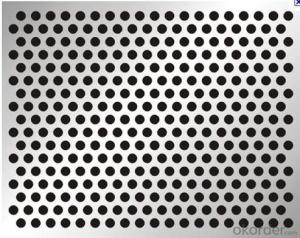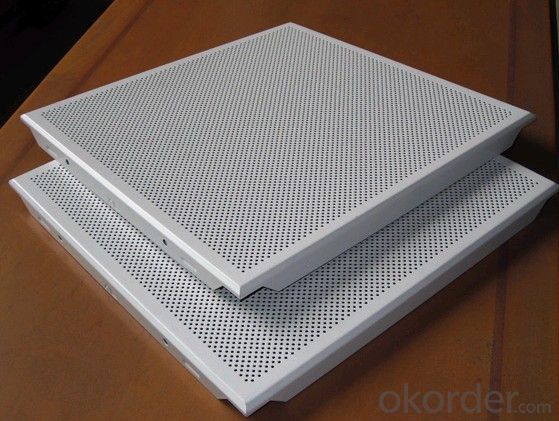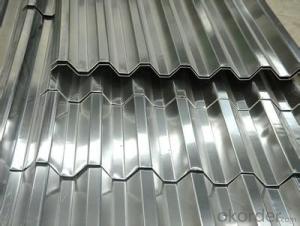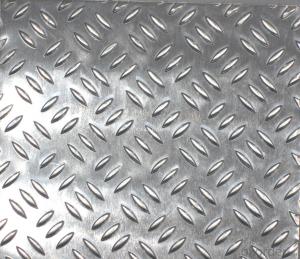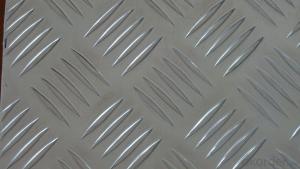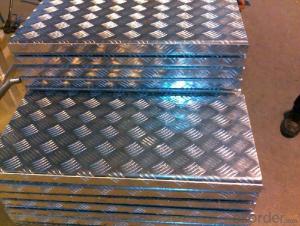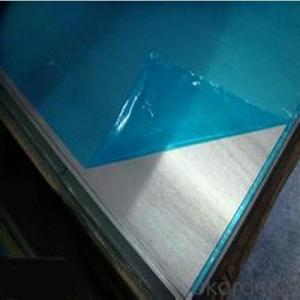Custom Aluminum Sheets in Mm for Roof
- Loading Port:
- China Main Port
- Payment Terms:
- TT OR LC
- Min Order Qty:
- -
- Supply Capability:
- -
OKorder Service Pledge
OKorder Financial Service
You Might Also Like
Aluminium alloys with a wide range of properties are used in engineering structures. Alloy systems are classified by a number system (ANSI) or by names indicating their main alloying constituents (DIN and ISO).
The strength and durability of aluminium alloys vary widely, not only as a result of the components of the specific alloy, but also as a result of heat treatments and manufacturing processes. A lack of knowledge of these aspects has from time to time led to improperly designed structures and gained aluminium a bad reputation.
One important structural limitation of aluminium alloys is their fatigue strength. Unlike steels, aluminium alloys have no well-defined fatigue limit, meaning that fatigue failure eventually occurs, under even very small cyclic loadings. This implies that engineers must assess these loads and design for a fixed life rather than an infinite life.
Another important property of aluminium alloys is their sensitivity to heat. Workshop procedures involving heating are complicated by the fact that aluminium, unlike steel, melts without first glowing red. Forming operations where a blow torch is used therefore require some expertise, since no visual signs reveal how close the material is to melting. Aluminium alloys, like all structural alloys, also are subject to internal stresses following heating operations such as welding and casting. The problem with aluminium alloys in this regard is their low melting point, which make them more susceptible to distortions from thermally induced stress relief. Controlled stress relief can be done during manufacturing by heat-treating the parts in an oven, followed by gradual cooling—in effect annealing the stresses.
The low melting point of aluminium alloys has not precluded their use in rocketry; even for use in constructing combustion chambers where gases can reach 3500 K. The Agena upper stage engine used a regeneratively cooled aluminium design for some parts of the nozzle, including the thermally critical throat region.
Another alloy of some value is aluminium bronze (Cu-Al alloy).
Aluminium foil acts as a total barrier to light and oxygen (which cause fats to oxidise or become rancid), odours and flavours, moistness, and germs, it is used broadly in food and pharmaceutical packaging. The purpose of aluminium is to make long-life packs (aseptic processing|aseptic packaging) for drinks and dairy goods, which allows storing without refrigeration. Aluminium foil containers and trays are used to bake pies and to pack takeaway meals, ready snacks and long life pet foods.
Aluminium foil is widely sold into the consumer market, often in rolls of 500 mm (20 in) width and several metres in length.It is used for wrapping food in order to preserve it, for example, when storing leftover food in a refrigerator (where it serves the additional purpose of preventing odour exchange), when taking sandwiches on a journey, or when selling some kinds of take-away or fast food. Tex-Mex restaurants in the United States, for example, typically provide take-away burritos wrapped in aluminium foil.
Aluminium foils thicker than 25 μm (1 mil) are impermeable to oxygen and water. Foils thinner than this become slightly permeable due to minute pinholes caused by the production process.
- Q: What are the different surface finishes available for aluminum sheet?
- There are several different surface finishes available for aluminum sheet, each offering unique aesthetic and functional properties. Some of the common surface finishes for aluminum sheet include: 1. Mill Finish: This is the most basic and widely used surface finish for aluminum sheet. It has a smooth, raw appearance with visible grain lines from the manufacturing process. 2. Brushed Finish: This finish is achieved by brushing the aluminum sheet with a fine abrasive material, creating a pattern of fine lines. It provides a satin-like appearance and is often used for decorative purposes. 3. Anodized Finish: This finish is created through an electrochemical process called anodizing, which forms a durable oxide layer on the surface of the aluminum sheet. Anodized finishes are available in various colors and offer enhanced corrosion resistance. 4. Polished Finish: This finish involves polishing the aluminum sheet to a high gloss or mirror-like surface. It provides a reflective and elegant appearance, making it suitable for decorative applications. 5. Embossed Finish: This finish involves embossing patterns or textures onto the surface of the aluminum sheet. It adds texture and visual interest to the sheet, making it ideal for architectural and decorative purposes. 6. Powder Coated Finish: In this finish, a dry powder is applied to the surface of the aluminum sheet and then heated to form a protective and decorative coating. Powder coated finishes are available in a wide range of colors and offer excellent durability and resistance to weathering. These are just a few of the many surface finishes available for aluminum sheet. The choice of finish depends on the intended application, desired appearance, and specific performance requirements.
- Q: Can aluminum sheets be textured or patterned?
- Yes, aluminum sheets can be textured or patterned through various processes such as embossing, engraving, or adding surface finishes like brushed, hammered, or matte patterns.
- Q: Is it possible to utilize aluminum sheets in interior design projects?
- <p>Yes, aluminum sheets can be used for interior design purposes. They are lightweight, durable, and resistant to corrosion, making them suitable for various applications such as wall cladding, ceilings, and furniture. Aluminum sheets can also be painted or anodized to achieve different finishes, adding aesthetic appeal to your design. However, it's important to consider the specific requirements of your project, such as load-bearing capacity and thermal insulation, as these properties can vary with different types of aluminum sheets.</p>
- Q: How does the grain structure of aluminum sheet affect its properties?
- The grain structure of aluminum sheet plays a significant role in determining its properties. The grain structure refers to the arrangement of individual aluminum crystals, also known as grains, within the sheet. The size, shape, and orientation of these grains can influence various mechanical and physical properties of the aluminum sheet. For instance, the grain structure affects the sheet's strength, ductility, hardness, and even its corrosion resistance. In terms of strength, a fine-grained aluminum sheet tends to have higher strength than a coarse-grained one. This is because the presence of smaller grains allows for more grain boundaries, which act as obstacles to dislocation movement and enhance the material's resistance to deformation. On the other hand, a coarse-grained structure has fewer grain boundaries, leading to reduced strength. Furthermore, the grain structure affects the sheet's ductility, which refers to its ability to deform without fracturing. Aluminum sheets with finer grains typically exhibit better ductility as the numerous grain boundaries hinder dislocation motion and prevent crack propagation. In contrast, coarser grains tend to promote crack propagation, resulting in reduced ductility. The hardness of aluminum sheet is also influenced by its grain structure. Generally, a fine-grained structure contributes to higher hardness due to increased dislocation density and grain boundary strengthening. Conversely, a coarse-grained structure leads to reduced hardness as there are fewer obstacles to dislocation motion. Moreover, the grain structure affects the sheet's corrosion resistance. Fine-grained aluminum sheets tend to have improved corrosion resistance compared to coarse-grained ones. This is because the presence of more grain boundaries in fine-grained structures impedes the movement of corrosive agents, thus reducing the likelihood of corrosion. In summary, the grain structure of aluminum sheet significantly impacts its properties. Fine-grained structures generally enhance strength, ductility, hardness, and corrosion resistance, while coarse-grained structures tend to have the opposite effects. Therefore, controlling and optimizing the grain structure during the manufacturing process is crucial in achieving the desired properties of aluminum sheet for various applications.
- Q: Can aluminum sheets be used for decorative ceiling panels?
- Aluminum sheets are indeed suitable for decorative ceiling panels. The versatility of aluminum as a material offers numerous advantages for this purpose. Its lightweight nature, durability, and resistance to corrosion make it an ideal choice for long-lasting use. Moreover, aluminum sheets can be easily molded and shaped into various designs, patterns, and textures, allowing for visually appealing ceiling panels. To enhance their aesthetic appeal and match the desired decor style, these panels can be finished with different coatings or finishes. Additionally, aluminum is a sustainable and eco-friendly material that can be recycled, making it an excellent option for those who prioritize environmental consciousness. In summary, the versatility, durability, and aesthetic potential of aluminum sheets make them an outstanding choice for decorative ceiling panels.
- Q: What are the necessary safety measures to be aware of when handling aluminum sheets?
- <p>When working with aluminum sheets, it's crucial to wear appropriate personal protective equipment (PPE), including gloves to prevent cuts and eye protection to shield against flying debris. Ensure good ventilation to avoid inhaling dust or fumes from cutting or polishing. Use sharp tools to minimize the risk of accidents and always cut away from your body. Keep the work area clean and free of clutter to prevent slips or trips. Be cautious of electrical hazards if using power tools, and ensure all tools are properly grounded. Finally, be aware of the fire hazard potential of aluminum dust and store it safely away from ignition sources.</p>
- Q: which kind of aluminum sheet could be bended after being etched?
- general etching materials include stainless steel and copper.
- Q: Can aluminum sheets be etched or engraved?
- Yes, aluminum sheets can be etched or engraved. Etching or engraving on aluminum sheets is a process that involves removing some of the material from the surface using acid or a high-powered laser. This can be done to create intricate designs, patterns, or even text on the aluminum sheet. The etching or engraving process can be used for various applications, such as signage, decorative pieces, or industrial parts. The resulting etched or engraved design on the aluminum sheet can be further enhanced by adding color or other finishes to create a desired look.
- Q: How do you determine the thickness tolerance of an aluminum sheet?
- To determine the thickness tolerance of an aluminum sheet, several factors need to be considered. Firstly, it is important to refer to the industry standards and specifications for aluminum sheets. These standards typically provide guidelines and tolerances for various thicknesses of aluminum sheets, which can vary depending on the specific alloy and grade of the material. Next, it is crucial to use precise measuring equipment such as calipers or micrometers to accurately measure the thickness of the aluminum sheet. Multiple measurements should be taken at different locations on the sheet to account for any potential variations. Once the measurements are obtained, they should be compared to the specified thickness tolerance provided by the industry standards. The tolerance typically represents the acceptable range within which the actual thickness of the sheet can vary. For instance, if the specified thickness tolerance is ±0.002 inches, it means that the sheet's thickness can vary within this range. If the measured thickness falls within the specified tolerance range, the sheet is considered to be within tolerance. However, if the measured thickness exceeds the upper or lower limit of the tolerance range, it indicates that the sheet is out of tolerance and may not meet the required specifications. In some cases, it may be necessary to consult with the manufacturer or supplier of the aluminum sheet to determine the specific tolerance requirements for a particular application. They can provide additional information and guidance regarding the appropriate thickness tolerance to ensure the sheet meets the intended purpose. Overall, determining the thickness tolerance of an aluminum sheet involves following industry standards, using accurate measuring equipment, and comparing the measured thickness to the specified tolerance range. This helps ensure that the sheet meets the required specifications and can be used effectively in various applications.
- Q: How do you clean aluminum sheets?
- To clean aluminum sheets, you can start by rinsing them with water to remove any loose dirt or debris. Then, create a mixture of mild dish soap and warm water. Use a soft cloth or sponge to gently scrub the aluminum sheets with the soapy solution. Avoid using abrasive cleaners or scrub brushes, as they can scratch the surface of the sheets. Once you've thoroughly cleaned the sheets, rinse them again with water and dry them with a clean towel or cloth.
Send your message to us
Custom Aluminum Sheets in Mm for Roof
- Loading Port:
- China Main Port
- Payment Terms:
- TT OR LC
- Min Order Qty:
- -
- Supply Capability:
- -
OKorder Service Pledge
OKorder Financial Service
Similar products
Hot products
Hot Searches
Related keywords
